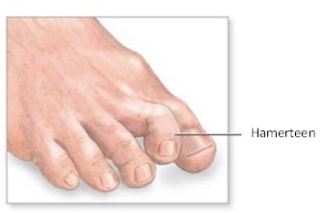Hammer toes are toes with bent joints. The reason for this is usually an imbalance between the toe flexor and extensor muscles. This is caused by, for example, incorrect shoes, joint inflammations, deviating foot position with deviating walking pattern, fracture, etc.
There are two types of hammer toes, based on the movement in the joints, namely:
A flexible hammer toe is one with flexible toe joints that you can stretch with your fingers. Generally, flexible hammer toes are less painful than rigid ones.
The rigid hammer toe cannot be stretched with your fingers. The rigid hammer toe can be very painful and severely limit walking ability.
Painful corns often develop on the hammer toes, because they press and rub against the shoe. The hammer toes also cause more pressure under the forefoot, which can cause overloading. Corns that develop on the hammer toes can be removed by a qualified pedicure. If these corns quickly recur, a podiatrist can offer solutions.
The solution depends on the type of hammer toe. Flexible hammer toes can often be treated well
with a flexible silicone orthosis. This orthosis ensures that the toes are stretched. Therapy of
a rigid hammer toe is usually more focused on protection. A stretching effect is difficult
to achieve, so the goal will then be protection and maintenance of the current position.
Painful forefeet as a result of hammer toes can be treated with an orthosis or with a
pressure-relieving therapeutic sole.
Sometimes it is necessary to operate on a hammer toe in the hospital.
